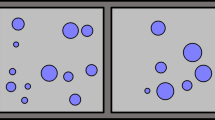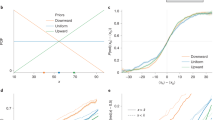Abstract
Number symbols are part of our everyday visual world. Here we show that merely looking at numbers causes a shift in covert attention to the left or right side, depending upon the number's magnitude. This observation implies obligatory activation of number meaning and signals a tight coupling of internal and external representations of space.
This is a preview of subscription content, access via your institution
Access options
Subscribe to this journal
Receive 12 print issues and online access
$209.00 per year
only $17.42 per issue
Buy this article
- Purchase on Springer Link
- Instant access to full article PDF
Prices may be subject to local taxes which are calculated during checkout

Similar content being viewed by others
References
Yantis, S. & Hillstrom, A.P. J. Exp. Psychol. Hum. Percept. Perform. 20, 95–107 (1994).
Folk, C.L., Remington, W. & Johnston, J.C. J. Exp. Psychol. Hum. Percept. Perform. 18, 1030–1044 (1992).
Hommel, B., Pratt, J., Colzano, L. & Godijn, R. Psychol. Sci. 12, 360–365 (2001).
Dehaene, S., Bossini, S. & Giraux, S.P. J. Exp. Psychol. Gen. 122, 371–396 (1993).
Fias, W., Brysbaert, M., Geypens, F. & d'Ydewalle, G. Math. Cognit. 2, 95–110 (1996).
Bächtold, D., Baumüller, M. & Brugger, P. Neuropsychologia 36, 731–735 (1998).
Fischer, M.H. Neurology 57, 822–826 (2001).
Dehaene, S. in The New Cognitive Neurosciences (ed. Gazzaniga, M.) 987–998 (MIT Press, Cambridge, Massachusetts, 2000).
Pratt, J., Spalek, T.M. & Bradshaw, F. J. Exp. Psychol. Hum. Percept. Perform. 25, 730–746 (1999).
Zorzi, M., Priftis, K. & Umilta, C. Nature 417, 138–139, (2002).
Dehaene, S. Psychol. Sci. 12, 244–246 (2001).
Gevers, W., Reynvoet, B. & Fias, W. Cognition 87, 87–95 (2003).
Acknowledgements
M.H.F. is supported by the British Academy (LRG 31696). A.D.C. and M.D.D. are supported by Natural Sciences and Engineering Research Council graduate fellowships. J.P. is supported by NSERC operating and equipment grants.
Author information
Authors and Affiliations
Corresponding author
Ethics declarations
Competing interests
The authors declare no competing financial interests.
Rights and permissions
About this article
Cite this article
Fischer, M., Castel, A., Dodd, M. et al. Perceiving numbers causes spatial shifts of attention. Nat Neurosci 6, 555–556 (2003). https://doi.org/10.1038/nn1066
Received:
Accepted:
Published:
Issue Date:
DOI: https://doi.org/10.1038/nn1066
This article is cited by
-
Perception of the temporal order of digits during rapid serial visual presentation is influenced by their ordinality
Psychological Research (2023)
-
A functional role for oculomotor preparation in mental arithmetic evidenced by the abducted eye paradigm
Psychological Research (2023)
-
Overlearned sequence and perceived time: possible involvement of attention
Psychological Research (2023)
-
Impact of deafness on numerical tasks implying visuospatial and verbal processes
Scientific Reports (2022)
-
Non-magnitude sources of bias on duration judgements for blank intervals: conceptual relatedness of interval markers reduces subjective interval duration
Psychological Research (2022)



